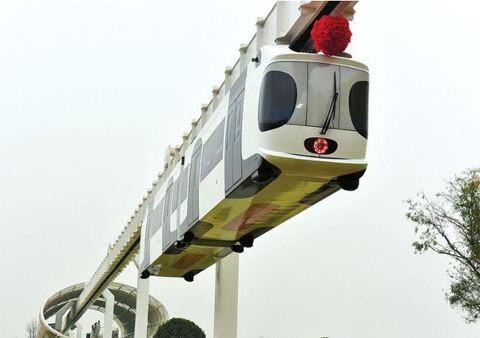
This September, engineers and designers in the Chinese city of Chengdu, Sichuan province successfully tested the first battery-powered suspended urban railway 空铁 (kōngtiě). This November, the “hanging” train was actually put into use! The train carries 120 passengers and can travel at a top speed of 60kph. The hanging train line is said to cost just 1/5th to 1/8th of the cost of typical underground subway trains. What has developers most excited about this hanging train is that it runs entirely on lithium battery power!
Many are hailing this as a potentially huge chance to change how people can travel around cities, as well as a good step forward for our environment. Chinese netizens are also enjoying the playful design of the train, which resembles the face of a panda bear.
Some other good features of the train include:
• 环保 (huánbǎo) Environmental protection
• 低成本 (dī chéngběn) Low cost
• 高安全性 (gāo ānquán xìng) High security and safety
So what do we call this new urban train? You can refer to this kind of transportation as “空铁 (kōngtiě).” Just as this train is new, the word 空铁 (kōngtiě) is new as well!
空 (kōng), an adjective meaning “empty, hollow or air.” Paired with:
铁 (tiě) a noun meaning “iron,” we get:
空铁 (kōngtiě) suspension railway/air rail.
Míngtiān wǒ yào chéng kōngtiě qù shàngbān.
明天 我 要 乘 空铁 去 上班。
Tomorrow, I will take the suspension railway to work.
A: Nǐ zěnme qù zhōngxīn gōngyuán?
A: 你 怎么 去 中心 公园?
A: How will you go to Central Park?
B: Wǒ zuò kōngtiě qù.
B: 我 坐 空铁 去。
B: I will take the air rail.
Although “空铁 (kōngtiě)” is a new word, the way we can use it in a sentence still follows other ways we describe using transportation in Chinese. When we need to inform someone of how we will take transportation, we use this sentence structure:
乘 (chéng)/坐 (zuò) + the mode of transportation {公交车 (gōngjiāochē) bus, 出租车 (chūzūchē) car, 地铁 (dìtiě) subway, etc.}+ the destination place.
Chéng fēijī qù běijīng.
乘 飞机 去 北京。
Take the plane to Beijing.
Zuò dìtiě huíjiā.
坐 地铁 回家。
Take the subway back home.

1. What is the totally new form of urban transportation in China called?
A. 地铁 (dìtiě)
B. 公交车 (gōngjiāochē)
C. 出租车 (chūzūchē)
D. 空铁 (kōngtiě)



